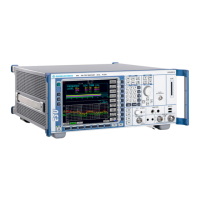Operating Manual 1302.6163.12 - 03 4.117
R&S ESU Instrument Functions
Analyzer Mode
4.8.4.1 Filter Types
• NORMAL (3dB): The resolution bandwidths are implemented by Gaussian filters
with the set 3 dB bandwidth and correspond approximately to the noise
bandwidth. For bandwidths up to 100 kHz, digital bandpass filters are used.
• EMI (6dB): The resolution bandwidths are implemented by Gaussian filters with
the set 6 dB bandwidth and correspond approximately to the pulse bandwidth. For
bandwidths up to 1 MHz, digital bandpass filters are used.
• FFT: An FFT is performed. For that purpose, the filtered IF signal is digitized and
then transformed into the spectral domain via FFT. The transformation range
depends on the selected filter bandwidths and can be set between 4 kHz to 50
kHz. If the span is larger than the transformation range, several transformations
are performed and the results are appended to each other in the spectral domain.
If the span is smaller than the transformation range, the measurement results are
interpolated when the number of measurement points provided by the FFT is
smaller than the number of display points in x-direction (625). A flattop window
serves as a window in the time domain so that high amplitude precision with good
selection is achieved.
Compared to bandpasses, FFT filters lead to significantly reduced sweep times.
For a span of 50 kHz and a bandwidth of 100 Hz, for instance, the sweep time is
reduced from 5 s to 40 ms. FFT filters are particularly suitable for stationary
signals (sinusoidal signals or signals that are continuously modulated in time). For
burst signals (TDMA) or pulsed signals, normal filters are preferable.
Additionally, a number of especially steep-edged channel filters are available for
power measurement.
• CHANNEL = general, steep-edged channel filters
• RRC = filters with root-raised cosine characteristic
(RRC = Root Raised Cosine)
As soon as the FFT filters are active (RBW ≤ 30 kHz) the sweep time display field
(SWT) is replaced by the acquisition time (AQT) display field.
FFT is a block transformation so the result depends on the time relation between
the data set to be transformed and the burst or pulsed signal. A gated sweep mea-
surement for TDMA signals is therefore not provided if FFT filters are used.
When the tracking generator (option R&S FSU-B9) is used as signal source for the
DUT, filtering with the FFT algorithm is not useful. The selection FFT is thus not
available if the tracking generator is switched on.
When the preselection is active, the FFT filter is not available.

